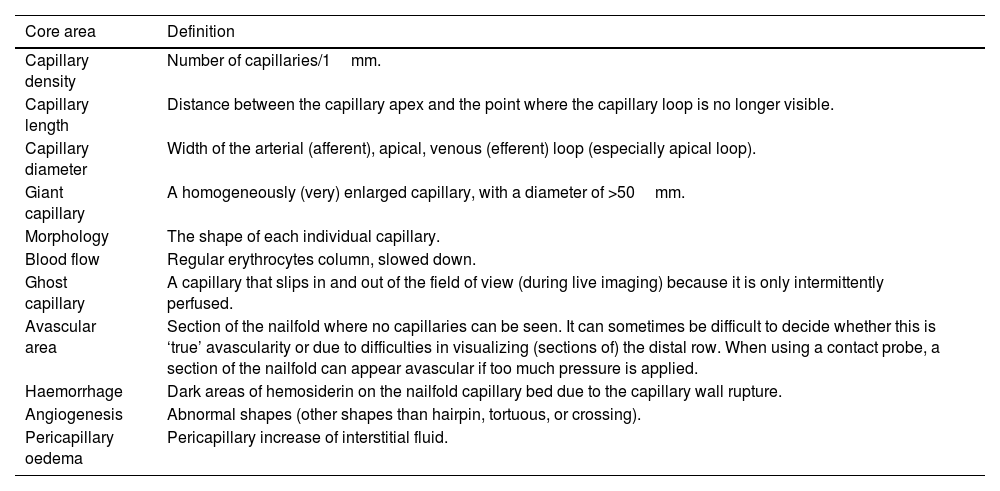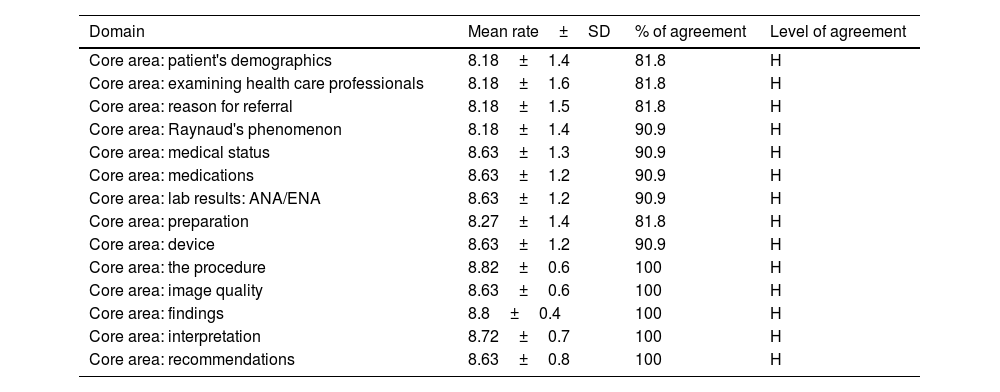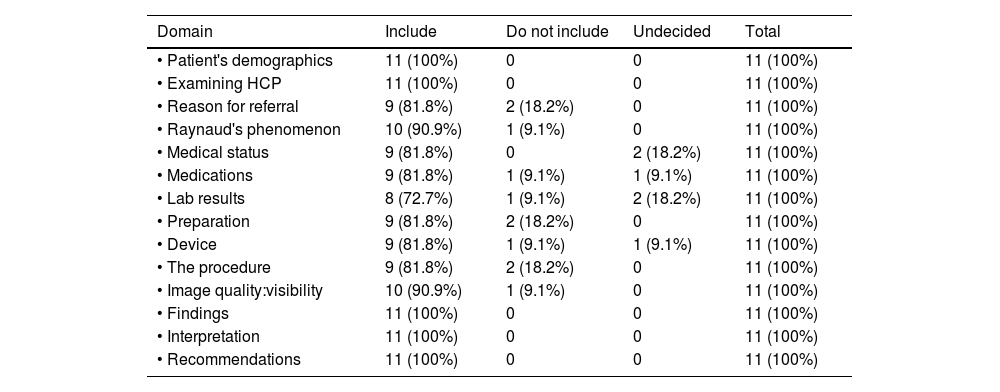The peripheral microangiopathy may be well evaluated and studied by nailfold capillaroscopy (NFC) which is a safe and non-invasive technique. NFC has been reported to have both diagnostic and prognostic values in patients presenting with Raynaud's phenomenon.
ObjectiveThe overarching objective of this work was to make a consensus on what domains should be included in a capillaroscopy report and that it can be used in daily clinical practice and clinical research in the area of rheumatology.
MethodsA Delphi questionnaire was developed regarding capillaroscopy report from a literature review and expert consensus. The first Delphi round included 14 core areas, its 18 domains with 50 subdomains, derived from a systematic literature review. The level of evidence was determined for each core set using the Oxford Centre for Evidence-based Medicine (CEBM) system. Nine response categories have been set per each item ranging between 1 and 9. Round 2, aimed to reach preliminary consensus “in” or “out” for domains. It included all items that were rated “critical” by at least 80% of the participants as well as any new domains proposed in round 1.
ResultsThe participants to the first, and second round were 11 experts. Fourteen domains were discussed in the two rounds. At the end of the survey, the final report template of NFC in rheumatology reached a consensus.
ConclusionA nailfold capillaroscopy report template has been developed by this study, based on outcomes of a Delphi process, by international participants panel. All domains met the 80% voting threshold set in this work. The reporting template can be used for both clinical research as well as day to day practice to provide guidance and standardize the NFC reporting.
La microangiopatía periférica puede ser evaluada y estudiada adecuadamente mediante capilaroscopia ungueal (NFC), que es una técnica segura y no invasiva. Se ha informado que la NFC tiene valores tanto diagnósticos como pronósticos en pacientes que presentan el fenómeno de Raynaud.
ObjetivoEl objetivo general de este trabajo fue aportar de manera objetiva y lograr un consenso sobre los dominios que se incluirán en los resultados de un modelo de informe de la NFC y que pueda ser aplicable tanto para la práctica clínica estándar como para la investigación clínica en reumatología.
MétodosSe elaboró un cuestionario Delphi sobre el informe de capilaroscopia a partir de una revisión bibliográfica y del consenso de expertos. La primera ronda Delphi incluyó 14 áreas centrales, sus 18 dominios con 50 subdominios, derivados de una revisión sistemática de la literatura. El nivel de evidencia se determinó para cada conjunto básico utilizando el sistema del Centro de Medicina basada en la Evidencia de Oxford. Se han establecido 9 categorías de respuesta para cada ítem, que oscilan entre 1 y 9. La ronda 2 tenía como objetivo llegar a un consenso preliminar «dentro» o «fuera» de los dominios. Incluía todos los elementos que fueron calificados como «críticos» por al menos el 80% de los participantes, así como cualquier dominio nuevo propuesto en la ronda 1.
ResultadosEn la primera y segunda ronda participaron 11 expertos. En las 2 rondas se discutieron 14 dominios. Al final de la encuesta, el modelo de informe final de la NFC en reumatología alcanzó un consenso.
ConclusiónEste estudio desarrolló una plantilla de informe de capilaroscopia ungueal, basada en los resultados de un proceso Delphi por un panel internacional de participantes. Todos los dominios alcanzaron el umbral de votación del 80% establecido en este trabajo. La plantilla de informes se puede utilizar tanto para la investigación clínica como para la práctica diaria, para proporcionar orientación y estandarizar los informes de la NFC.












